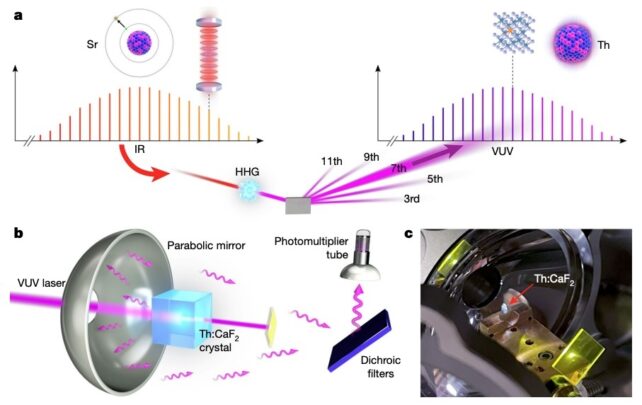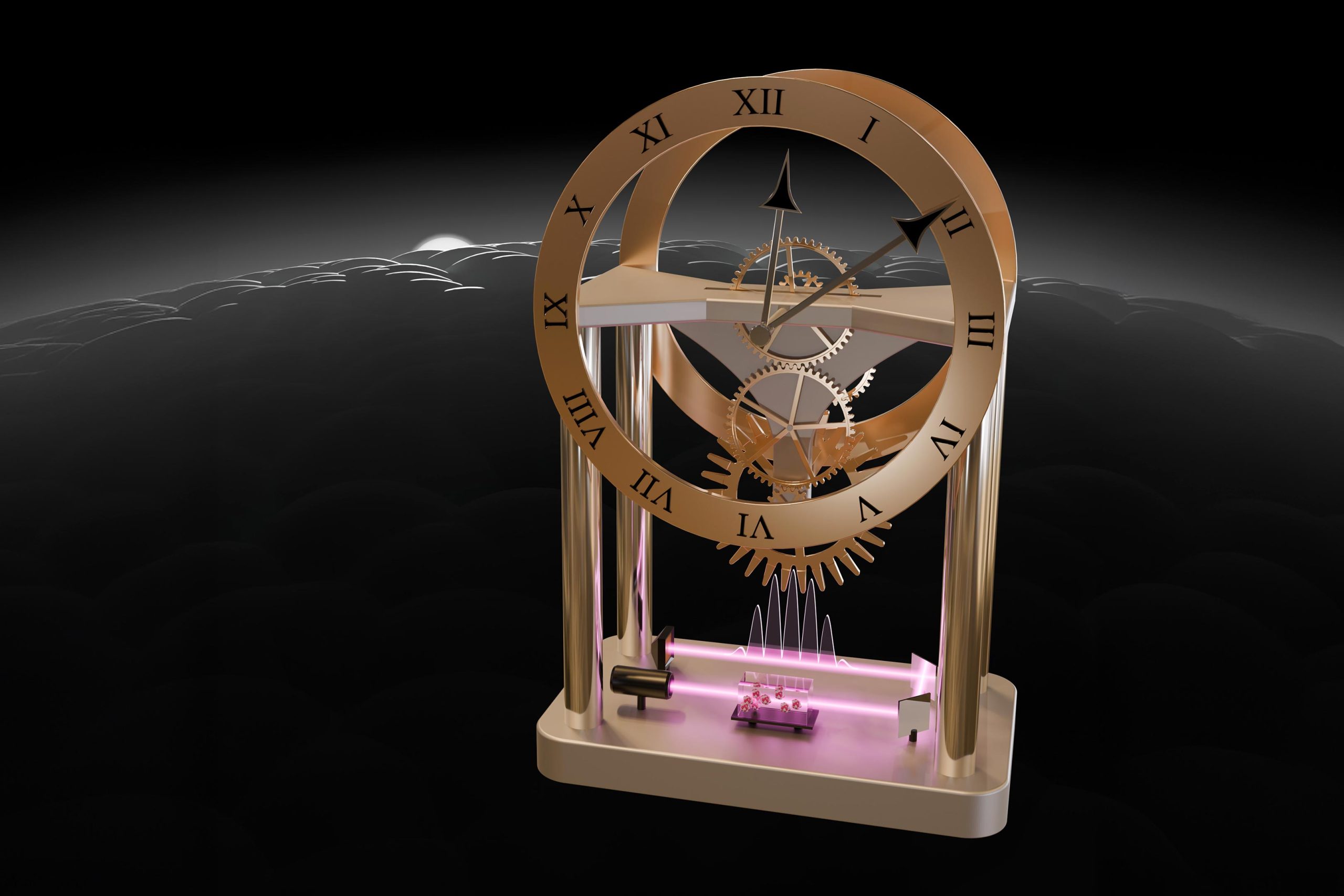博文
科学家创造了世界上第一个核钟原型
 精选
精选
||
科学家创造了世界上第一个核钟原型
诸平
据奥地利维也纳工业大学(Vienna University of Technology)2024年9月4日提供的消息,突破:科学家创造了世界上第一个核钟原型(Michelle Starr. Breakthrough: Scientists Create World's First Nuclear Clock Prototype,ScienceAlert, 05 September 2024)。
Fig. 1 The nuclear clock experimental apparatus. (Chuankun Zhang/JILA)
一个历经数十年的巨大突破在几个月前(just a few months ago)取得,科学家们已经意识到它的潜力:对钍原子核(thorium nucleus)量子能态之间差距的测量已被用于制造第一个基本的核时钟(rudimentary nuclear clock)。
通过将锶原子钟(strontium atomic clock)与含有钍原子核的晶体相结合,一组物理学家成功地展示了核心技术,这将使我们第一个完全实现和开发的核时钟(nuclear clock)。这一尚未达到的里程碑将开启一个全新的超精确计时领域。相关研究结果于2024年9月4日已经在《自然》(Nature)杂志网站在线发表——Chuankun Zhang, Tian Ooi, Jacob S. Higgins, Jack F. Doyle, Lars von der Wense, Kjeld Beeks, Adrian Leitner, Georgy Kazakov, Peng Li, Peter G. Thirolf, Thorsten Schumm, Jun Ye. Frequency ratio of the 229mTh isomeric transition and the 87Sr atomic clock. Nature, 2024 Sep; 633(8028): 63-70. DOI: 10.1038/s41586-024-07839-6. Published: 04 September 2024
参与此项研究的有来自美国科罗拉多大学博尔德分校(JILA, University of Colorado Boulder, Boulder, CO, USA)、美国国家标准与技术研究院(NIST, Boulder, CO, USA)、德国美因茨约翰内斯•古登堡大学(Johannes Gutenberg-Universität Mainz, Mainz, Germany)、奥地利维也纳工业大学(TU Wien, Vienna, Austria)、瑞士洛桑联邦理工学院{École Polytechnique Fédérale de Lausanne (EPFL), Lausanne, Switzerland}、IMRA美国(IMRA America, Ann Arbor, MI, USA)以及德国慕尼黑路德维希-迈克希米利安大学(Ludwig-Maximilians-Universität München, Garching, Germany)的研究人员。
维也纳工业大学的物理学家索斯藤·舒姆(Thorsten Schumm)解释说:“有了这个第一个原型,我们已经证明:钍可以用作超高精度测量的计时器。剩下要做的就是技术开发工作,预计不会再有重大障碍了。”
原子钟是一种依赖于原子在激光刺激下在能量状态之间切换时非常精确的“滴答”声的钟,这是由围绕原子核旋转的电子的状态决定的。然而,这对于原子核本身来说要困难得多,因为改变原子核的能态比改变电子的能态需要更多的能量。
不过,核钟是非常可取的,因为它将比原子钟更加稳定和精确。反过来,核时钟将能够更精确地测量物理宇宙(physical Universe),这对从导航到寻找暗物质(dark matter)的所有事情都有影响。
2024年早些时候宣布(announced earlier this year)了对钍原子核能量状态差的能量跳跃的测量。这使得索斯藤·舒姆和他的同事们能够确定产生能量状态变化所需的精确能量,这是核时钟运行的机制。
下一步是证明他们可以从这种滴答声中创造出一个时钟,这就是索斯藤·舒姆和他的同事们现在所做的。他们展示的时钟并不是完整的核时钟,但在这个方向上迈出了第一步。
美国国家标准与技术研究所的实验天体物理联合研究所(Joint Institute of Laboratory Astrophysics简称JILA)(JILA at the National Institute of Standards & Technology)的锶(Sr)原子钟(strontium clock)是使用红外光操作的。该团队创造了一个含有钍(Th)核的小氟化钙晶体(calcium fluoride crystal),其能量状态是用真空紫外光(vacuum ultraviolet light)切换的。

Fig. 2 A schematic showing how the thorium crystal is coupled to the strontium atomic clock. (Zhang et al., Nature, 2024)
为了将晶体与原子钟结合起来,研究人员需要找到一种将红外光转换为紫外线的方法。他们创造了一个红外波长的频率梳,并让它通过氙气,氙气与红外光相互作用,发出紫外线。结果是一个组合频率梳,可以激发钍原子核的跃迁,并使其与锶原子的滴答声同步。
研究人员说,由此产生的核滴答声并不比锶原子钟更精确,但现在核心概念已经得到证明,实际技术就在眼前,而且非常接近全面实现。
“想象一下,即使你让手表运行数十亿年,它也不会慢一秒。虽然我们还没有完全做到这一点,但这项研究使我们更接近这种精确度,”JILA的物理学家叶军(Jun Ye音译)说。
这个研究团队已经做了很多次实验;每一次,他们都取得了与原子钟一致的结果。下一步将使其完善。
索斯藤·舒姆(Thorsten Schumm)说:“当我们第一次激发这种转变时,我们能够确定频率在几兆赫兹以内。这已经比以前所知道的任何事情都好1000倍以上了。然而,现在我们在千赫兹范围内的精度又提高了100万倍,这样,我们有望在2-3年内超越最好的原子钟。”
本研究得到了美国陆军研究办公室{Army Research Office (grant no. W911NF2010182)}、空军科学研究办公室{Air Force Office of Scientific Research (grant no. FA9550-19-1-0148)}、美国国家自然科学基金{National Science Foundation (grants no. QLCI OMA-2016244; PHY-2317149)}、美国国家标准与技术研究院(National Institute of Standards and Technology)、美国国家研究委员会博士后奖学金(National Research Council Postdoctoral Fellowship)、德国洪堡基金会的费奥多尔··吕嫩奖学金(Feodor Lynen fellowship from the Humboldt Foundation)、欧洲研究理事会{European Research Council (Horizon 2020, grant no. 856415)}、欧盟地平线2020计划{European Union’s Horizon 2020 Programme (grant no. 664732)}以及奥地利科学基金{Austrian Science Fund (grant DOI: 10.55776/F1004, 10.55776/J4834 and 10.55776/ PIN9526523)}的资助或支持。
上述介绍,仅供参考。欲了解更多信息,敬请注意浏览原文或者相关报道。
Precision Meets Power in the World’s First Thorium Nuclear Clock
The World's First Nuclear Clock
Ultraprecise Timekeeping: This New Nuclear Clock Won’t Lose a Second in a Billion Years
Optical atomic clocks1,2 use electronic energy levels to precisely keep track of time. A clock based on nuclear energy levels promises a next-generation platform for precision metrology and fundamental physics studies. Thorium-229 nuclei exhibit a uniquely low-energy nuclear transition within reach of state-of-the-art vacuum ultraviolet (VUV) laser light sources and have, therefore, been proposed for construction of a nuclear clock3,4. However, quantum-state-resolved spectroscopy of the 229mTh isomer to determine the underlying nuclear structure and establish a direct frequency connection with existing atomic clocks has yet to be performed. Here, we use a VUV frequency comb to directly excite the narrow 229Th nuclear clock transition in a solid-state CaF2 host material and determine the absolute transition frequency. We stabilize the fundamental frequency comb to the JILA 87Sr clock2 and coherently upconvert the fundamental to its seventh harmonic in the VUV range by using a femtosecond enhancement cavity. This VUV comb establishes a frequency link between nuclear and electronic energy levels and allows us to directly measure the frequency ratio of the 229Th nuclear clock transition and the 87Sr atomic clock. We also precisely measure the nuclear quadrupole splittings and extract intrinsic properties of the isomer. These results mark the start of nuclear-based solid-state optical clocks and demonstrate the first comparison, to our knowledge, of nuclear and atomic clocks for fundamental physics studies. This work represents a confluence of precision metrology, ultrafast strong-field physics, nuclear physics and fundamental physics.
https://blog.sciencenet.cn/blog-212210-1450105.html
上一篇:边缘的原子
下一篇:激素悖论:睾酮如何同时助长和抑制癌症

